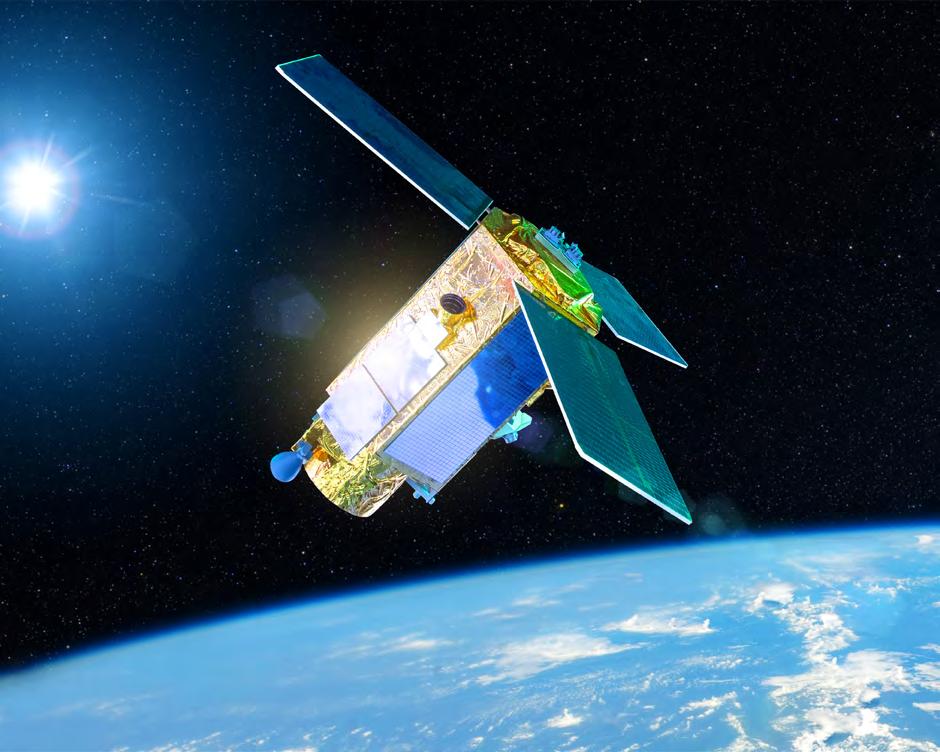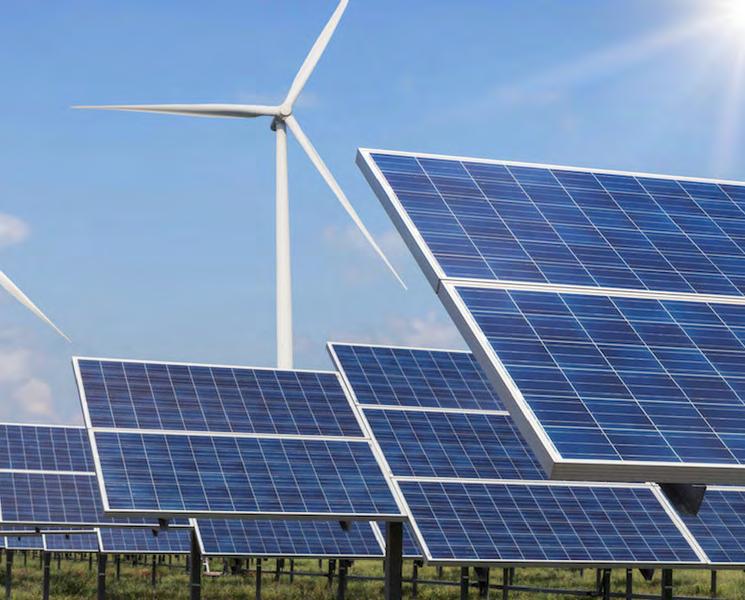
















With our customers at the center of every decision and action, Rogers is powering, protecting, and connecting the world — safely and reliably — through engineered materials and innovation. As the pace of change accelerates across our industry, we remain committed to helping our customers solve complex challenges and deliver meaningful impact for society.
I am pleased to share Rogers Corporation’s 2025 Sustainability Report Supplement—an update that reflects the progress we have made in integrating ethical, social, and environmental practices into our core business strategies. This work is grounded in our belief that sustainability and innovation are complementary drivers of long-term value.
Our materials play a critical role in enabling global shifts toward electrification, energy efficiency, and highperformance connectivity. From electric vehicles and advanced driver assistance systems to renewable energy and aerospace, our innovation strategy is tightly aligned with long-term secular trends like decarbonization and industrial transformation.
Within our own operations, we continue to make progress to reduce greenhouse gas emissions, improve supply chain sustainability, and design products that help customers meet their own sustainability goals.
At Rogers, our people are our greatest strength. Every day, we show up guided by our Cultural Behaviors, with safety as our top priority. We have seen continued reductions in recordable injuries, but we remain firmly committed to our goal: zero injuries. That commitment fuels our ongoing journey of safety leadership. We have cultivated a workplace where employees feel valued, respected, and connected as a team, and where innovation thrives as a result.

Strong governance continues to anchor our sustainability approach. Last year, we added a dedicated sustainability leader to support our ESG efforts across our global sites. Our senior management team and the Board of Directors remain actively engaged, ensuring that our sustainability commitments stay aligned with long-term business outcomes and the expectations of our stakeholders.
We are energized by the opportunities ahead. As our customers and industries transform, Rogers will remain a trusted partner—delivering the materials that move the world forward.

Colin Gouveia President and Chief Executive Officer Rogers Corporation
The Rogers 2025 Sustainability Report Supplement (Supplement) covers information from January 1, 2024, to December 31, 2024, except where noted.
This Supplement provides an update to the data provided in Rogers’ 2024 ESG Report along with key progress in our sustainability program in calendar year 2024. This Supplement aligns with reporting frameworks including the Sustainability Accounting Standards Board (SASB), specifically the Hardware Industry standard for the Technology & Communications Sector (TC-HW) (Version 2023-12), and the Task Force on Climate-related Financial Disclosures (TCFD), both of which are now a part of the International Sustainability Standards Board (ISSB).
Energy consumption and greenhouse gas emissions data contained in this report have been independently verified by Cameron-Cole, LLC to provide a limited level of assurance against the criteria of the WRI/WBCSD Greenhouse Gas Protocol. The full verification opinion is available on our website
The data presented in this report is prepared using accepted methodologies and assumptions based on relevant guidance. While our data has undergone internal vetting and believed reasonably accurate at time of preparation, it is important to acknowledge inherent uncertainties and limitations in data collection and presentation. Performance data may be revised due to factors such as new data availability, industry-driven changes to methodologies, improvements in data collection, or corporate activities like joint ventures, mergers and acquisitions, or divestitures.
For more detailed coverage of our environmental, social, and governance (ESG) initiatives beyond what is presented in this Supplement, please refer to Rogers’ 2024 ESG Report available on our website.

Rogers Corporation (NYSE:ROG) (Rogers) is a global technology leader that designs, engineers, and produces specialty materials and components.
Founded in 1832, Rogers has a strong legacy of delivering materials and design knowledge that is helping to make the world cleaner, safer, and better connected. Rogers corporate headquarters is located in Arizona (USA) and operates manufacturing facilities in the United States, Europe, and Asia. Our global reach includes sales offices worldwide.
Rogers serves a wide range of industries delivering highly engineered and differentiated offerings to help solve our customers’ most complex challenges. Rogers’ key business units, Advanced Electronic Solutions (AES) and Elastomeric
Material Solutions (EMS), drive innovation across a variety of markets, including automotive, industrial, aerospace, defense, portable electronics, wireless infrastructure, and renewable energy.
Rogers designs, develops, manufactures, and sells highperformance and high reliability engineered materials and components to meet our customers’ demanding challenges. We are focused on Helping power, protect, connect our world®.
Our commitment to corporate responsibility is central to our business and identity. Our sustainability objectives seek to reflect the interests of our stakeholders as well as embody Rogers’ Cultural Behaviors that guide our interactions, organizational objectives, and aim to make a positive impact in everything that we do.
Rogers is dedicated to protecting and preserving the environment through sustainably minded initiatives including environmentally responsible manufacturing processes, sustainable product stewardship, and developing products that are used in a variety of clean technology applications.
For example, Rogers’ advanced curamik® power substrates deliver efficient power conversion in applications for the electric and hybrid-electric vehicle (EV/HEV), renewable energy and industrial markets. Also, Rogers’ PORON® and BISCO® solutions help to improve the efficiency and durability of EV/HEV batteries and Battery Energy Storage Systems (BESS) which harness energy from clean sources. Rogers collaborates directly with customers by designing sustainable products to assist them in achieving their corporate sustainability goals.
Rogers is committed to reducing Scope 1 and 2 GHG emissions by 20% by 2030 in our manufacturing sites through employing a range of energy efficiency and renewable energy opportunities.
We value improved carbon efficiency from both environmental and economic perspectives. Recognizing that fuel sources are the largest contributors to our Scope 1 and 2 GHG emissions portfolio, we developed an Energy Management Plan and began implementing energy optimization projects across our operations, completing 16 projects in 2024. For example, solar panels installed at our Suzhou, China facility are projected to reduce emissions by 3,000 metric tons of CO 2 e annually, helping lower energy purchases, mitigate the risks of rising energy costs, and address the adverse effects of climate change. Additionally, we began a thorough assessment of our utility provider engagements to evaluate how we can increase our procurement of renewable forms of energy where feasible going forward.
“Rogers’ journey to reduce greenhouse gas emissions reflects our unwavering commitment to building a sustainable future. Through energy efficiency initiatives and leveraging renewable energy opportunities, we are driving meaningful progress—not only in our own environmental stewardship but also in creating positive impacts for our customers and communities.”
Paula Strand Director Technical
Operations
Total Energy Consumption by Source (MWh)
We monitor our water consumption and waste disposal with the aim to better understand our environmental footprint and to identify opportunities to minimize waste. Rogers treats industrial wastewater through permitted on-site treatment systems and discharges to municipal treatment plants. Rogers’ facilities have waste management programs in
place to properly handle, store, and ship for off-site disposal of hazardous waste they may generate. E-waste is collected and recycled in accordance with the specific requirements of the local agencies in the jurisdictions in which they operate. Rogers works with certified companies to ensure proper management and disposal of all waste.
Our employees are the driving force behind our success and Rogers is committed to enhancing our employees’ well-being, fostering their professional growth and development, and improving the communities in which we operate.
We believe empowering our employees to bring their unique perspectives and experiences to work every day drives the heartbeat of innovation, and that, first and foremost, we have a responsibility to protect our coworkers and communities by prioritizing health and safety conduct.
Rogers strives to make our workplace safe and aligned with excellence. Rogers’ Global Safety Management System (SMS) ensures workplace safety across all facilities. The SMS is made up of the following five elements: Management Commitment, Employee Engagement, Worksite Analysis, Control of Hazards,
and Training. The elements are reassessed regularly to ensure continuous improvement and alignment with evolving changes. In response to Rogers’ 2023 Global Safety Perception Survey, Rogers developed company-wide and site-specific safety actions to ensure safety is emphasized in discussions and employee interactions.
We also continued our Serious 10 Safety Rules campaign that focuses on addressing high-risk activities where noncompliance has the potential to result in serious injuries. These rules are shared at employee and contractor trainings and in messages throughout the year. We focused on the following topics in 2024: Heat Illness Prevention and Contractor Safety. Every three years, corporate safety and environmental audits are scheduled in our global locations. In 2024, no major risks or opportunities were identified during Environmental Management System certifications. Through consistent execution of our safety protocols, Rogers continues to see a decline in its number of recordable injuries and corresponding injury rates, and zero occupational fatalities were reported across our facilities globally in 2024.
To view Rogers’ EH&S and other management certifications, visit our Corporate Responsibility Certifications website
1
Rogers invests in its employees through professional development programs, workplace benefits, and employee resource groups. With a long history of promoting and enabling a wide variety of perspectives and skills, we have updated our program, “We Are Rogers: Our People, Our Values,” to signify our continued commitment of inviting a variety of viewpoints, hiring the best talent, and amplifying the voices of all employees. In 2024, we offered a variety of programs to support and develop our employees including mentoring, professional development programs, leadership training, a continuous learning platform, tuition reimbursement, and gift matching, among others. We also provided a comprehensive range of benefits to employees across the globe to promote the health and welfare of our workforce.
As a responsible employer and global multinational company, we believe that when we listen to what is both common and different, we become more informed, more open-minded, and more innovative as an organization. Rogers’ employee resource groups (ERGs) are open to all full-time employees and are one example of how Rogers supported a variety of topics important to our employees in 2024. For example, the Mental Health Alliance held 16 events focusing on a range of topics like guided meditations and increased its membership to 110 employees, and Women@Rogers has broadened its reach by incorporating our South Korea location into its network. Through these employee-driven groups, Rogers celebrates the differences in our global workforce and encourages employees to bring their whole selves to work.
Our continuing success derives from our talented and dedicated employees globally, who are responsible for the innovation, operations, and ethics foundational to our business and its future. We employ approximately 3,200 people in North America, EMEA and APAC.1



Rogers is an equal opportunity employer and does not make employment decisions based on age, race/ethnicity, sex, veteran status, disability, citizenship status, national origin, or any other characteristic protected by applicable law. All gender, race, and ethnicity information is voluntarily self-reported; as permitted by applicable law, Rogers uses such self-disclosed personal information to understand and analyze its workforce and contribute to third-party studies and reports such as this one. Rogers is required to use aggregated data to comply with certain government recordkeeping and reporting requirements. We take measures to protect employee confidentiality by aggregating or deidentifying the data. The numbers may not reflect the actual number of employees within each category; totals may not equal the sums of the categories. Self-reported information does not in any way affect the terms or conditions of employment and is not used in a manner inconsistent with applicable civil rights laws.
Rogers is an equal opportunity employer and does not make employment decisions based on age, race/ethnicity, sex, veteran status, disability, citizenship status, national origin, or any other characteristic protected by applicable law. All gender, race, and ethnicity information is voluntarily self-reported; as permitted by applicable law, Rogers uses such self-disclosed personal information to understand and analyze its workforce and contribute to third-party studies and reports such as this one. Rogers is required to use aggregated data to comply with certain government recordkeeping and reporting requirements. We take measures to protect employee confidentiality by aggregating or deidentifying the data. The numbers may not reflect the actual number of employees within each category; totals may not equal the sums of the categories. Self-reported information does not in any way affect the terms or conditions of employment and is not used in a manner inconsistent with applicable civil rights laws.
At Rogers, we firmly believe that the way we manage our business operations is as significant as the success we achieve. Our integrity-based reputation is anchored in strong governance and a dedication to sustainable and ethical business operations.
Rogers maintains a robust governance framework to promote accountability and transparency for sustainability matters and ESG practices throughout our business operations. Our Board has oversight of ESG and provides guidance through the Nominating, Governance and Sustainability Committee. In addition, Rogers maintains a management level ESG Steering Committee consisting of cross functional membership of senior leaders and subject matter experts to recommend and implement ESG objectives that align with Rogers’ business objectives.
As part of Rogers continued commitment to sustainability, Rogers implemented several program enhancements in 2024. A new Sustainability Director role was created with a responsibility to strengthen and promote sustainability efforts worldwide. Two projects were initiated to better understand material ESG matters relevant to Rogers’ business and value chain: a double materiality assessment that considers ESG topics from the perspective of both financial impact as well as societal impact, and a climate risk assessment that evaluates risks and opportunities related to managing and adapting to changes brought on by global warming conditions. The results of these assessments will help inform Rogers’ strategic approach towards related risks, opportunities, and impacts, helping to drive business value, improve responsiveness to stakeholders, and support emerging regulatory expectations. More details on our corporate Governance structure can be reviewed in more detail in our Annual Report, Proxy Statement, the 2024 ESG Report, and on our website Additional information relevant to SASB- and TCFD-aligned disclosures is presented in the indices that follow this section.
“Creating a dedicated role focused on corporate sustainability within an organization is a significant step towards integrating ethical, social, and environmental considerations into the core of business strategies and operations. At Rogers, we view sustainability not as just a department, but a dimension of quality that touches every aspect of our operations and resonates with every stakeholder. Our
commitment to advancing sustainable practices and aligning our company’s activities with broader societal goals is fundamental to our culture, values, and the long-term success of our business. It is a journey I am excited to be a part of.”
Christine Ackerson Sustainability Director
Rogers reports information aligned to the SASB framework, Technology and Communications, Hardware sector, our designated industry classification according to SASB’s Sustainable Industry Classification System®. 2 The activity metrics prescribed by SASB include topics most relevant to our sector and support consistent reporting across related industry groups.
Disclosure Code
TC-HW-000.A
Number of units products by product category
Rogers’ advanced materials are “Components” within the applicable SASB product categorization; however, Rogers does not explicitly disclose commercially sensitive unit production.
TC-HW-000.B Area of manufacturing facilities 2,742,600 square feet.
TC-HW-000.C
Percentage production from owned facilities
99% of production by revenue is from Rogers-owned facilities.
Product Security
Disclosure Code
TC-HW-230a.1
Description of approach to identifying and addressing data security risks in products
Rogers manufactures and sells advanced materials that do not contain or process data, or include embedded software, as delivered to customers. As such, Rogers’ products do not have any inherent data security risks.
2 For more information, see Hardware Sustainability Accounting Standard (Sustainability Accounting Standards Board, Version 2023-12).
TC-HW-330a.1 Percentage of (1) gender and (2) diversity group representation for (a) executive management, (b) non-executive management, (c) technical employees, and (d) all other employees
TC-HW-410a.1 Percentage of products by revenue that contain IEC 62474 declarable substances
For Workforce Composition information, please see the Social section of this Supplement.
TC-HW-410a.2 Percentage of eligible products, by revenue, meeting the requirements for EPEAT registration or equivalent
For information on products that contain IEC 62474 Declarable Substances, please refer to the Certifications page of our website for relevant product documentation. Rogers complies with national laws and global regulations (EU Restriction on Hazardous Substances (RoHS), Registration, Evaluation, Authorization and Restriction of Chemicals (REACH), etc.) and conducts compliance reviews of materials used in production. Periodic analysis of final products is also performed.
Electronic Product Environmental Assessment Tool (EPEAT) registration or equivalent is not directly applicable to Rogers’ products, because these registration structures are designed for complete end products, and Rogers does not manufacture complete end products, but rather manufactures and sells components for these products. Rogers manufactures and sells advanced materials that are consistent with EPEAT criteria and the core principles of environmentally preferred products. Accordingly, Rogers’ advanced materials are specifically designed for end products registered under EPEAT.
TC-HW-410a.3 Percentage of eligible products, by revenue, certified to an energy efficiency certification
TC-HW-410a.4 Weight of end-of-life products and e-waste recovered, percentage recycled
Energy efficiency certifications, such as ENERGY STAR, are not directly applicable to Rogers’ products because they are designed for complete end products. Rogers manufactures and sells advanced materials that are consistent with ENERGY STAR criteria and the core principles of energy efficiency. Accordingly, Rogers’ advanced materials are specifically designed for end products meeting ENERGY STAR criteria.
End-of-life metrics, including e-waste recovery and recycling, are not directly applicable to Rogers’ products, because these metrics are designed for complete end products. Several of Rogers’ product lines incorporate copper, which is widely recovered, and recycled as part of standard end-of-life programs for electronics end products.
TC-HW-430a.1 Percentage of Tier 1 supplier facilities audited in the RBA Validated Audit Process (VAP) or equivalent, by (a) all facilities and (b) high-risk facilities
Rogers conducts internal reviews as part of its supplier selection and maintenance processes but does not currently conduct independent RBA audits with suppliers. In our interactions with suppliers, Rogers seeks to conduct our business with honesty and integrity, fostering mutual respect and collaboration, adhering to our Code of Business Ethics . Suppliers must comply with our Code as required by Rogers' Standard Terms and Conditions of Purchase.
The Code includes provisions on labor and human rights, health and safety, the environment, and fair competition, among others. Rogers will not tolerate any instances of human trafficking, forced labor, child labor, or other forms of modern slavery, for additional information about our related policies and processes please refer to Rogers’ Modern Slavery and Human Trafficking Statement on our website.
TC-HW-430a.2 Tier 1 suppliers’ (1) nonconformance rate with the RBA Validated Audit Process (VAP) or equivalent, and (2) associated corrective action rate for (a) priority nonconformances and (b) other non-conformances
Refer to the answer provided to TC-HW-430a.1.
TC-HW-440a.1 Description of the management of risks associated with the use of critical materials
Rogers’ advanced materials require limited usage of “critical materials,” as defined by the SASB standard. As a result, Rogers does not believe these materials represent a significant risk to the organization. Rogers’ suppliers of critical materials are well-established business partners with contractual pricing agreements, business continuity measures, and acceptance of Rogers’ Code of Business Ethics and Conflict Minerals policy.
Rogers monitors suppliers to prioritize and develop mitigation plans proactively in case of supply chain disruption. Such mitigation measures include dual-sourcing, product standardization, and building out a buffer inventory. In the event of a future disruption, this data can provide Rogers with the information required to assess the potential impact and enable a quick response to help mitigate the impact to our customers.
This Supplement also includes disclosures aligned with the recommendations of the TCFD (now part of the International Sustainability Standards Board (ISSB)) to outline Rogers’ approach to climate-related risks and opportunities across four key areas: governance, strategy, risk management, and metrics and targets.
Describe the board's oversight of climate-related risks and opportunities.
Climate-related risks, opportunities, and progress are reviewed bi-annually by the Board of Directors. The board’s Nominating, Governance, & Sustainability (NG&S) Committee is responsible for oversight of ESG matters, including climate-related topics. The NG&S Committee provides guidance to management to ensure that the company is appropriately addressing climate-related considerations, including in its overall business strategy, and aligned with the interests of our stakeholders.
Describe management’s role in assessing and managing climate related risks and opportunities.
Rogers’ ESG Steering Committee is responsible for assessing and managing climate-related risks and opportunities. The ESG Steering Committee is a cross-functional team with participants from the Business, Legal & Compliance, Human Resources, Operations, Environmental Health & Safety, Supply Chain, Investor Relations, Research & Development, Information Technology, and Finance. The ESG Steering Committee meets regularly (typically monthly) and reports to the Executive Leadership Team.
Beginning in late 2024, Rogers initiated a climate-related assessment to evaluate physical and transition risks and opportunities. This assessment will be completed in 2025, and recommendations will be considered in future planning according to the TCFD framework and other relevant standards.
Describe the climate-related risks and opportunities the organization has identified over the short, medium, and long term.
We recognize the importance of identifying and managing climate-related risks and opportunities and regularly monitor the regulatory landscape in the jurisdictions where we operate and assess the potential impacts to the resiliency of our business from a technology, markets, and reputational perspective. Please refer to Rogers 10K for specific climate-related risks and opportunities currently considered.
A climate risk assessment to evaluate physical and transition risks and opportunities relevant to Rogers’ business will be completed in 2025. This assessment includes scenario analysis across different time horizons and future scenarios, considering climate-related transition risks and opportunities as well as climate-related physical risks across Rogers’ asset portfolio. The recommended actions from this assessment will be considered in future reporting. Describe the impact of climate-related risks and opportunities on the organization’s businesses, strategy, and financial planning.
Describe the resilience of the organization’s strategy, taking into consideration different climate-related scenarios, including a 2°C or lower scenario.
Describe the organization’s processes for identifying and assessing climate-related risks.
Describe the organization’s processes for managing climate-related risks.
Describe how processes for identifying, assessing, and managing climate-related risks are integrated into the organization’s overall risk management.
Led by our Risk Management Steering Committee and with oversight by the Board of Directors, management conducts an annual Enterprise Risk Management (ERM) process to identify the top risks relevant to the company. The process involves sending out a survey to participants to review and analyze a list of identified risks. The survey asks participants to rate each risk based on the impact and likelihood of it occurring across three levels. Following the survey, the ERM Committee releases the results to the Executive Leadership Team, Board of Directors, and participants to review and determine the priority risks. Once determined, the ERM Committee ensures that these risks are adequately monitored or mitigated in the near- and medium-term by Risk Mitigation Leads and considered in the long term as part of our strategic planning.
Climate-related risks were identified as a top risk by the ERM Committee. Ownership of this risk sits with the Legal & Compliance and Sustainability Departments, who are responsible for regular tracking and reporting of ESG and climate-related matters. Climate-related risks are assessed on an ongoing basis and reported to management vis-a-vis the ESG and ERM Committees.
Disclose the metrics used by the organization to assess climate related risks and opportunities in line with its strategy and risk management process.
Disclose Scope 1, Scope 2, and, if appropriate, Scope 3 GHG emissions, and the related risks.
Describe the targets used by the organization to manage climate-related risks and opportunities and performance against targets.
Rogers tracks and reports Scope 1 and Scope 2 GHG emissions measured in MT CO2e. To support these calculations, we track underlying source data, such as energy consumption (MWh). Additionally, Rogers tracks energy intensity across its manufacturing facilities to inform progress on energy efficiency measures (MT CO2e per million USD revenue). Other goals and targets will be considered as recommended outcomes of climate-related risk and double materiality assessments or as required by regulatory requirements. For latest metrics, please refer to the Environment section of this Supplement.
For latest Scope 1 and 2 metrics, please refer to the Environment section of this Supplement. In 2025, Rogers plans to begin data collection for Scope 3 categories material to our business activities.
Rogers announced a public target to reduce Scope 1 and 2 GHG emissions by 20% by 2030, compared to a 2022 base year. Progress against this target is reported annually and communicated to management and the Board. For latest progress towards this goal, please refer to the Environment section of this Supplement.
Forward Looking Statements are generally accompanied by words such as “anticipate,” “assume,” “believe,” “could,” “estimate,” “expect,” “foresee,” “goal,” “intend,” “may,” “might,” “plan,” “potential,” “predict,” “project,” “should,” “seek,” “target” or similar expressions that convey uncertainty as to future events or outcomes. Forward-looking statements are based on assumptions and beliefs that we believe to be reasonable; however, assumed facts almost always vary from actual results, and the differences between assumed facts and actual results could be material depending upon the circumstances. Where we express an expectation or belief as to future results, that expectation or belief is expressed in good faith and based on assumptions believed to have a reasonable basis. We cannot assure you, however, that the stated expectation or belief will occur or be achieved or accomplished. Among the factors that could cause our results to differ materially from those indicated by forward looking statements are risks and uncertainties inherent in our business including, without limitation: failure to capitalize on, volatility within, or other adverse changes with respect to our growth drivers, such as delays in adoption or implementation of new technologies; failure to successfully execute on our long-term growth strategy; uncertain business, economic and political conditions in the U.S. and abroad, particularly in China, South Korea, Germany, Belgium, England, and Hungary, where we maintain significant manufacturing, sales or administrative operations; the trade policy dynamics between the U.S. and other countries where we do business, in particular China, as reflected in recently escalated tariff impositions and associated countermeasures, as well as the potential for U.S.-China supply chain decoupling; fluctuations in foreign currency exchange rates; our ability to develop innovative products and the extent to which they are incorporated into end-user products and systems; the extent to which end-user products and systems incorporating our products achieve commercial success; the ability and willingness of our sole or
limited source suppliers to deliver certain key raw materials, including commodities, to us in a timely and cost-effective manner; business interruptions due to catastrophes or other similar events, such as natural disasters, war, terrorism or public health crises; the impact of sanctions, export controls and other foreign asset or investment restrictions; failure to realize, or delays in the realization of anticipated benefits of acquisitions and divestitures due to, among other things, the existence of unknown liabilities or difficulty integrating acquired businesses; our ability to attract and retain management and skilled technical personnel; our ability to protect our proprietary technology from infringement by third parties and/or allegations that our technology infringes third party rights; changes in effective tax rates or tax laws and regulations in the jurisdictions in which we operate; failure to comply with financial and restrictive covenants in our credit agreement or restrictions on our operational and financial flexibility due to such covenants; the outcome of ongoing and future litigation, including our asbestos-related product liability litigation; changes in environmental laws and regulations applicable to our business; and disruptions in, or breaches of, our information technology systems. Should any risks and uncertainties develop into actual events, these developments could have a material adverse effect on the Company. Our forward-looking statements are expressly qualified by these cautionary statements, which you should consider carefully. For additional information about the risks, uncertainties and other factors that may affect our business, please see our most recent annual report on Form 10-K and any subsequent reports filed with the Securities and Exchange Commission, including quarterly reports on Form 10-Q. Rogers Corporation assumes no responsibility to update or revise any forward-looking statements contained herein, whether as a result of new information, future events or otherwise, except as required by law.
2225 W Chandler Blvd
Chandler, Arizona 85224, US
CorporateResponsibility@rogerscorporation.com
@RogersCorporation
@Rogers_Corp
@RogersCorporation
@rogers-corporation
Corporate Blog - Rogers Corporation